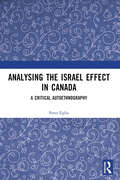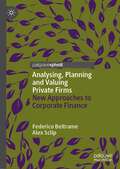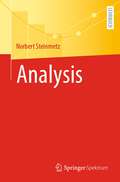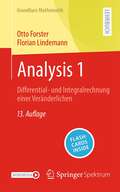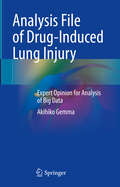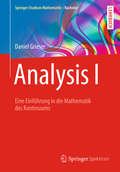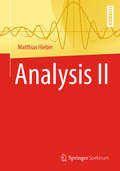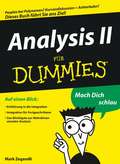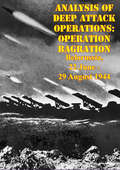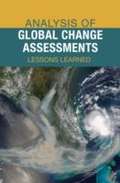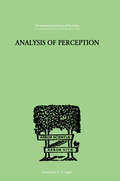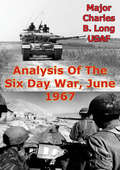- Table View
- List View
Analysing the History of British Social Welfare: Compassion, Coercion and Beyond
by Jonathan ParkerThis book offers insights into the development of social welfare policies by exploring the interconnections between policies and practice throughout history. It challenges tacitly accepted arguments that favour particular approaches to welfare, such as conditionality and eligibility. It provides examples of enduring social assumptions which influence the way we perform social welfare, such as the equivocal position of women in social welfare and the unintended consequences of reforms such as Universal Credit. By identifying continuities in welfare policy, practice and thought, it offers the potential for the development of new thinking, policy making and practice.
Analysing the Instructional Setting: A Guide for Course Designers
by Duncan Harris Martin TessmerDesigned to overcome flaws during the planning and design stages of educational or training courses, this guide explains the importance of physical factors in the instructional environment, the roles of the instructor and learner, and the gathering of information on the learning environment.
Analysing the Israel Effect in Canada: A Critical AutoEthnography
by Peter EglinWhat is the life of a Palestinian worth to intellectuals in Canadian universities and news media? Analyzing the Israel Effect documents and analyzes the discursive and organizational methods by which public criticism of Israel’s oppression of the Palestinians is silenced in Canada, as experienced through ten episodes in the life of the author over a thirty-year period from 1990-2020 in interaction with his university and local and national Canadian news media.As a sociological work the book is a critical autoethnography. But it is also an atrocity tale, a horror story of institutional self-censorship amounting to the abrogation of intellectual responsibility by those specifically charged with upholding it. In the end, the book is a crossover between academic treatise and journalistic exposé, “a historical narrative written by an academic from the standpoint of a political participant-observer” (Rajan Philips). The Israel Effect itself is analyzed as a three-tier propaganda industry. Hasbara is produced in Israel (Tier 1), disseminated to Israel Lobby groups around the world (Tier 2) and independently re-produced, actively and passively, by the “intellectual” institutions – universities and news media (Tier 3). This book is about the non-Jewish, non-Zionist institutions of Tier 3, the onlookers to war crimes, ethnic cleansing and, arguably, genocide, as in Gaza in October-November 2023.This work stands as a compelling testament to the importance of preserving freedom of expression, and the vital role intellectuals play in challenging injustice and promoting transparency. It is ideal for scholars, activists, and anyone seeking to understand the complexities of political activism and the power dynamics behind public discourse.
Analysing the Screenplay
by Jill NelmesMost producers and directors acknowledge the crucial role of the screenplay, yet the film script has received little academic attention until recently, even though the screenplay has been in existence since the end of the 19th century. Analysing the Screenplay highlights the screenplay as an important form in itself, as opposed to merely being the first stage of the production process. It explores a number of possible approaches to studying the screenplay, considering the depth and breadth of the subject area, including: the history and early development of the screenplay in the United States, France and Britain the process of screenplay writing and its peculiar relationship to film production the assumption that the screenplay is standardised in form and certain stories or styles are universal the range of writing outside the mainstream, from independent film to story ideas in Bhutanese film production to animation possible critical approaches to analysing the screenplay. Analysing the Screenplay is a comprehensive anthology, offering a global selection of contributions from internationally renowned, specialist authors. Together they provide readers with an insight into this fascinating yet complex written form. This anthology will be of interest to undergraduate and postgraduate students on a range of Film Studies courses, particularly those on scriptwriting.
Analysing the Trust–Transparency Nexus: Multi-level Governance in the UK, France and Germany (Civil Society and Social Change)
by Alistair Cole Ian StaffordIs transparency a necessary condition to build and restore citizen and civil society trust in governance and democracy? Throughout Europe, there is a growing demand for effective forms of citizen engagement and decentralisation in policy-making to increase trust and engage increasingly diverse populations. This volume addresses the relationship between trust and transparency in the context of multi-level governance. Drawing on fieldwork from the UK, France and Germany, this comparative analysis examines different efforts to build trust between key actors involved in decision-making at the sub-national level. It outlines the challenges of delivering this agenda and explores the paradox that trust might require transparency, yet in some instances transparency may undermine trust.
Analysing, Planning and Valuing Private Firms: New Approaches to Corporate Finance
by Federico Beltrame Alex SclipCorporate finance plays a vital role in every business as it pertains to an array of financing and investment decisions. Where most corporate finance books provide tools for public companies, this book presents new approaches and methods for planning and valuing private firms. Chapters discuss how typical valuation methods may not be perfectly adaptable to private firms and their investment decisions: in particular showing how the widely used Capital Asset Pricing Model cannot be precisely applied for the estimation of cost of equity for private companies, and the limitations of market multiples which may not match individual company features.The book suggests new ways of financial forecasting that can be better tailored to private businesses, such as by exploiting the concept of financial breakeven based on debt serviceability that departs from the more traditionally used concept of the revenue-cost breakeven. Topics including financial planning, working capital management, the cost of capital, and valuation methods are all covered. This book will be of interest to consultants, analysts and accountants working in private firms, as well as academics and students who are interested in an empirical assessment of the role of corporate finance in private businesses versus larger public companies.
Analysis
by Norbert SteinmetzDas Buch wendet sich sowohl an Studierende aller mathematischen Fachrichtungen und mathematisch interessierte Studierende der Physik als auch an Dozentinnen und Dozenten, die den Aufbau ihres ersten Analysiskurses noch vor sich haben oder Anregungen für ihre Vorlesungen suchen. Inhalt und Form sind entstanden und vielfach erprobt in immer wieder kritisch veränderten und angepassten 3-semestrigen Analysiskursen. Etwa 2/3 des Buches decken die Erfordernisse einer 2-semestrigen Grundvorlesung Analysis ab, wohingegen das restliche Drittel Elemente der Fourieranalysis, der Differentialgeometrie, der gewöhnlichen Differentialgleichungen und der Funktionentheorie behandeln, Themen, denen eigenständige Vorlesungen auch weiterhin zu wünschen sind. Zu den Besonderheiten zählen die parallele und miteinander verzahnte Einführung des Riemann- und Lebesgueintegrals, die Einbettung einfacher Elemente der komplexen in die reelle Analysis, ausgedehnte Anwendungen – von der Heisenbergschen Unschärferelation über die Lösung der Wärmeleitungsgleichung bis hin zur Black-Scholes-Formel – sowie die Darstellung der Methode von Ostrogradski und des Dixon-Beweises der allgemeinen Cauchyschen Integralformel. Dass an verschiedenen Stellen die eingefahrenen Pfade verlassen wurden, wird der kundigen Leserschaft nicht verborgen bleiben. Die Frage „abstrakt oder anschaulich-verständlich“ wird konsequent zugunsten des letzteren entschieden. Die Übungsaufgaben sind in den laufenden Text eingebaut in der Hoffnung, dass sie so mehr Beachtung finden. Schließlich vermitteln die historischen Anmerkungen und Kurzbiographien einen Eindruck davon, wie die Analysis sich entwickelt hat und wer wesentlich an dieser Entwicklung beteiligt war.
Analysis 1: Differential- und Integralrechnung einer Veränderlichen (Grundkurs Mathematik)
by Otto Forster Florian LindemannDieses fest etablierte Lehrbuch begleitet Studierende der Mathematik, Physik und Informatik seit über vier Jahrzehnten durch die Analysis des ersten Semesters. Es gelangt in systematischer Weise, aber ohne zu große Abstraktionen, einfach und verständlich zu den grundlegenden Begriffen (Konvergenz von Folgen und Reihen, Stetigkeit, Differentiation, Riemannsches Integral) und illustriert sie mit zahlreichen Beispielen. Die numerische Seite der Analysis wird an verschiedenen Stellen beleuchtet, um den Grenzwertbegriff konkreter zu machen. Das Buch schließt mit zwei Kapiteln über Taylor- und Fourier-Reihen, in denen alle bis dahin gelernten Techniken zum Einsatz kommen. Jedes Kapitel enthält Übungsaufgaben zum Vertiefen der Inhalte. Für die vorliegende Auflage wurde der Text einschließlich aller Abbildungen erneut überarbeitet. Darüber hinaus ergänzen nun elektronische Flashcards das Buch: Diese per App zugänglichen Verständnisfragen unterstützen den Lernprozess und eignen sich auch sehr gut zur Prüfungsvorbereitung.
Analysis 1: Ein zuverlässiger und verständlicher Begleiter für Studium und Prüfung
by Martin Brokate Florian Lindemann Johannes ZimmerZiel dieses Lehrbuchs ist es, das Material des ersten Semesters eines Vorlesungszyklus zur Analysis prägnant und verständlich darzustellen und darüber hinaus Ausblicke und Ergänzungen zu geben, die den Stoff lebendig werden lassen. Besonderer Wert wird auf die Motivation der zu behandelnden Themen gelegt. Zu Beginn des Buchs wird die mathematische Denkweise, insbesondere Beweistechniken und axiomatisches Vorgehen, ausführlich eingeführt. Dieses Buch basiert auf Vorlesungen, die regelmäßig und seit vielen Jahren an der TU München abgehalten werden. Zahlreiche Abbildungen veranschaulichen die behandelten Konzepte und Ideen. Zudem ermöglicht dieses Lehrbuch den Zugriff auf mehr als 250 interaktive Aufgaben in der Springer Nature Flashcards-App, mit denen Wissen und Verständnis überprüft werden kann – hervorragend geeignet auch zur Prüfungsvorbereitung.
Analysis 2: Differentialrechnung im ℝⁿ, gewöhnliche Differentialgleichungen (Grundkurs Mathematik)
by Otto Forster Florian LindemannDieses fest etablierte Lehrbuch begleitet Studierende der Mathematik, Physik und Informatik durch die Analysis des zweiten Semesters, genauer: durch die mehrdimensionale Differentialrechnung sowie die gewöhnlichen Differentialgleichungen. Bei der Darstellung wurden allzu große Abstraktionen vermieden, stattdessen wird die Theorie durch viele konkrete Beispiele erläutert – insbesondere solche, die für die Physik relevant sind. Jedes Kapitel enthält Übungsaufgaben zum Vertiefen der Inhalte. Für die vorliegende Auflage wurde der Text vollständig überarbeitet. Darüber hinaus ergänzen nun elektronische Flashcards das Buch: Diese per App zugänglichen Verständnisfragen unterstützen den Lernprozess und eignen sich auch sehr gut zur Prüfungsvorbereitung.
Analysis File of Drug-Induced Lung Injury: Expert Opinion for Analysis of Big Data
by Akihiko GemmaThis book describes the pathologic conditions of drug-induced lung injuries, monitoring strategies, and guides on how to interpret the evidence. It also dives into particular drugs that caused the disorder, such as EGFR inhibitors, anti-EGFR antibodies, mTOR inhibitors, proteasome inhibitors, immune checkpoint inhibitors, neoangiogenesis inhibitors, and other molecular targeted drugs. It outlines the analysis and interpretation of the post-marketing survey on surveillance of each drug for inducing pulmonary lesions presenting diffuse haziness. The data and analysis from this survey are valuable since a guideline is yet to be established due to limited clinical evidence and cases. As new drugs are developed, establishing treatment and event management is crucial. Thus, Drug-induced Pulmonary Disorder in Medical Oncology - Expert Opinion to Decipher Big Data summarizes the accumulated information to provide a foundation for further research advancement. The book offers a refreshing alternative to current approaches to medical oncology and respiratory diseases professionals and will also attract medical affairs members in global pharmaceutical companies.
Analysis I
by Adrian ConstantinDas Buch umfasst die Analysis in einer Veränderlichen. Es behandelt den Stoff der Vorlesung Analysis 1, wie er gewöhnlich an Hochschulen im deutschsprachigen Raum gelehrt wird und ist sowohl als Lehrbuch als auch zum vertiefenden Selbststudium geeignet. Zahlreiche Beispiele und Übungsaufgaben werden bereitgestellt. Geschichtliche Hintergründe sind durchgehend zu finden. Darüber hinaus wird das wechselseitig fordernde Ineinandergreifen von Theorie und Anwendungen anhand vieler ausführlich beschriebener Themen veranschaulicht, und kurze Erläuterungen bieten eine Einsichtsperspektive zu fortgeschritteneren Gebieten der Analysis.
Analysis I
by Matthias HieberDieses Lehrbuch zeichnet sich durch einen klaren und modernen Aufbau aus und ist auf eine breit angelegte Grundausbildung ausgerichtet. Es ist der erste Band einer zweiteiligen Einführung in die Analysis, die Studierende der Mathematik und verwandter Studienrichtungen (etwa Physik, Informatik und Ingenieurwissenschaften) sowie deren Dozenten anspricht. Zentrale Grundkonzepte werden bereits frühzeitig eingeführt und diskutiert – jedoch zunächst nicht in einem allgemeinen, sondern in einem angemessenen und überschaubaren Rahmen. Diese Konzepte werden anschließend mit steigender Komplexität vertiefend behandelt und aus verschiedenen Blickwinkeln beleuchtet. Eine Vielzahl von Beispielen und Aufgaben zeigt die Vernetzung und Verzahnung der Analysis mit anderen Teilgebieten der Mathematik und gibt den Studierenden weitreichende Möglichkeiten, ihr Wissen und Verständnis dieser Thematik zu vertiefen bzw. zu verbreitern. Kapitelweise ausgelagerte Anmerkungen und Ergänzungen dienen als Zusatz- und Hintergrundinformation zum behandelten Stoff und runden diesen ab, ohne den Blick auf das Wesentliche zu verstellen.
Analysis I: Eine Einführung in die Mathematik des Kontinuums (Springer Studium Mathematik - Bachelor)
by Daniel GrieserEntdecken Sie die höhere Mathematik für sich: Was sind die komplexen Zahlen, wie steht es mit der Unendlichkeit, ist 0,999. . . =1 und was steckt hinter der berühmten Eulerschen Formel? Mit diesem kompakten Lehrbuch der Analysis werden Sie dies und vieles mehr verstehen und sich dabei die Grundlagen für das Studium der Mathematik und der Naturwissenschaften aneignen. Das Buch ist aus dem beliebten, in Zusammenarbeit mit Studierenden entstandenen Skript des Autors entstanden und unterstützt Sie besonders beim Übergang von der Schule ins Studium. Mathematische Präzision gepaart mit anschaulichen Erklärungen und motivierenden Beispielen - das wird dieses Buch zu Ihrem ständigen Begleiter machen.
Analysis II
by Matthias HieberDieses Lehrbuch zeichnet sich durch einen klaren und modernen Aufbau aus und ist auf eine breit angelegte Grundausbildung ausgerichtet. Es ist der zweite Band einer Einführung in die Analysis, die Studierende der Mathematik und verwandter Studienrichtungen (etwa Physik, Informatik und Ingenieurwissenschaften) sowie deren Dozenten anspricht. Zentrale Grundkonzepte werden bereits frühzeitig eingeführt und diskutiert – jedoch zunächst nicht in einem allgemeinen, sondern in einem angemessenen und überschaubaren Rahmen. Diese Konzepte werden anschließend mit steigender Komplexität vertiefend behandelt und aus verschiedenen Blickwinkeln beleuchtet. Eine Vielzahl von Beispielen und Aufgaben zeigt die Vernetzung und Verzahnung der Analysis mit anderen Teilgebieten der Mathematik und gibt den Studierenden weitreichende Möglichkeiten, ihr Wissen und Verständnis dieser Thematik zu vertiefen bzw. zu verbreitern. Kapitelweise ausgelagerte Anmerkungen und Ergänzungen dienen als Zusatz- und Hintergrundinformation zum behandelten Stoff und runden diesen ab, ohne den Blick auf das Wesentliche zu verstellen.
Analysis II für Dummies (Für Dummies)
by Mark ZegarelliNach der Analysis ist vor der Analysis. Dies ist das richtige Buch für Sie, wenn es in der Analysis ein wenig mehr sein soll oder auch muss. Mark Zegarelli erklärt Ihnen, was Sie zur infiniten Integration und zu differential- und multivariablen Gleichungen wissen müssen. Er fährt mit Taylorreihe und Substitutionen fort und führt Sie auch in die Dritte Dimension der Analysis; und das ist lange noch nicht alles! Im Ton verbindlich, in der Sache kompetent führt er Ihre Analysiskenntnisse auf eine neue Stufe.
Analysis Of Biological Networks
by Falk Schreiber Björn H. JunkerAn introduction to biological networks and methods for their analysis Analysis of Biological Networks is the first book of its kind to provide readers with a comprehensive introduction to the structural analysis of biological networks at the interface of biology and computer science. The book begins with a brief overview of biological networks and graph theory/graph algorithms and goes on to explore: global network properties, network centralities, network motifs, network clustering, Petri nets, signal transduction and gene regulation networks, protein interaction networks, metabolic networks, phylogenetic networks, ecological networks, and correlation networks. Analysis of Biological Networks is a self-contained introduction to this important research topic, assumes no expert knowledge in computer science or biology, and is accessible to professionals and students alike. Each chapter concludes with a summary of main points and with exercises for readers to test their understanding of the material presented. Additionally, an FTP site with links to author-provided data for the book is available for deeper study. This book is suitable as a resource for researchers in computer science, biology, bioinformatics, advanced biochemistry, and the life sciences, and also serves as an ideal reference text for graduate-level courses in bioinformatics and biological research.
Analysis Of Deep Attack Operations: Operation Bagration, Belorussia, 22 June - 29 August 1944 [Illustrated Edition]
by Lieutenant Colonel William M. ConnorIncludes the World War Two On The Eastern Front (1941-1945) Illustration Pack - 198 photos/illustrations and 46 maps.Operation BAGRATION took place during what the Soviet analysts consider the third period of the war: that of the Soviet strategic offensives which marked the ascendancy of the Soviet armed forces over the German Wehrmacht. During this period, the armed forces of the Soviet Union held the strategic initiative and used it to defeat the Wehrmacht, gain control of Eastern Europe, and invade Germany proper, meeting Allied forces on the Elbe River on 25 April 1945. The period is regarded as beginning Jan. 1944 and ending with the V-E Day, 7 May 1945.By the beginning of 1944, the Red Army clearly had the initiative on the Eastern Front; moreover, since the beginning of the second period, the Soviet Union also had strong allies who could provide assistance in two ways: the U.S. and Great Britain...The invasions of Sicily and Italy followed in the second period, knocking Italy out of its alliance with Germany and diverting German forces to defend in Italy. The invasion of Sicily may also have contributed to the German decision to break off its Kursk offensives as well in July 1943...In the third period of the war, therefore, the Soviet Union held the strategic initiative, and the year opened with the first two of what would come to be known as the "Ten Destructive Blows" of 1944: Leningrad and the Ukraine. The offensive at Leningrad commenced on 14 Jan. 1944 and ground to a halt on 1 March with the German siege of Leningrad broken, the German Sixteenth and Eighteenth Armies defeated, Soviet advances of up to 200 kilometers, and Soviet forces on the border of Estonia. The blow in the Ukraine commenced on 24 Jan. 1944, lasting until mid-April, and involved all of the fronts in the Ukraine. Finally, the various fronts were ordered by Stavka to go on the defensive between 17 April and 6 May to prepare for the summer offensive.
Analysis Of Engineering Design Studies For Demilitarization Of Assembled Chemical Weapons At Blue Grass Army Depot
by National Research Council of the National AcademiesThe Program Manager for Assembled Chemical Weapons Assessment (PMACWA) of the Department of Defense (DOD) requested the National Research Council (NRC) to assess the engineering design studies (EDSs) developed by Parsons/Honeywell and General Atomics for a chemical demilitarization facility to completely dispose of the assembled chemical weapons at the Pueblo Chemical Depot in Pueblo, Colorado. To accomplish the task, the NRC formed the Committee on Review and Evaluation of Alternative Technologies for Demilitarization of Assembled Chemical Weapons: Phase II (ACW II Committee). This report presents the results of the committee's scientific and technical assessment, which will assist the Office of the Secretary of Defense in selecting the technology package for destroying the chemical munitions at Pueblo.
Analysis Of German Operation Art Failures, The Battle Of Britain, 1940
by Lieutenant Colonel John TurnerThe Battle of Britain was the first major defeat for the Germans of WWII. The Battle of Britain was an air operation designed to give Germany air superiority over both the English Channel and England. Gaining air superiority was considered by the Germany Army and Navy as absolutely essential prior to "Operation Sea Lion," the landing and invasion of England. Because the Luftwaffe was never able to establish the requisite air superiority, Sea Lion was cancelled.This paper examines the German Operational Art issues from a historical perspective. It concludes the failure of the Luftwaffe belongs to Reich-Marshall Goring, operational commander for the Battle of Britain. His main failure, as operational commander, was repeatedly making tactical decisions from the operational level rather than leaving this to on-the-scene tactical commanders. Secondly, he was never able to identify Fighter Command as the British Center of Gravity. Thirdly, he never understood the intelligence advantage gained by the British as a result of their newly invented radar early warning system. As a result, Germany lost the battle.
Analysis Of Global Change Assessments Lessons Learned
by National Research Council of the National AcademiesGlobal change assessments inform decision makers about the scientific underpinnings of a range of environmental issues, such as climate change, stratospheric ozone depletion, and loss of biodiversity. Dozens of assessments have been conducted to date by various U.S. and international groups, many of them influencing public policies, technology development, and research directions. This report analyzes strengths and weaknesses of eight past assessments to inform future efforts. Common elements of effective assessments include strong leadership, extensive engagement with interested and affected parties, a transparent science-policy interface, and well defined communication strategies. The report identifies 11 essential elements of effective assessments and recommends that future assessments include decision support tools that make use of information at the regional and local level where decisions are made.
Analysis Of Perception (International Library Of Psychology Ser.)
by Smythies, J RFirst published in 1999. Routledge is an imprint of Taylor & Francis, an informa company.
Analysis Of The Battle Of Iwo Jima
by Major Charles F. Sprietsma"Among Americans who served on Iwo Island, uncommon valor was a common virtue". This statement by Fleet Admiral Nimitz following the Battle of Iwo Jima succinctly summarizes the degree of effort, dedication, and personal sacrifice required of American servicemen to capture the island. The Japanese defenders also displayed these qualities, but the United States forces prevailed because they combined this effort, dedication, and sacrifice with superior application of basic principles of warfighting. Analysis of the application of these principles will help us understand why the battle developed and ended as it did. To do this, we must first examine the battle itself.
Analysis Of The Relationship Between Technology And Strategy And How They Shaped The Confederate States Navy [Illustrated Edition]
by Lt-Cmd Wesley A. BrownIncludes 23 illustrations and 3 tables.This study investigates the use of technology by the Confederate States of America to develop naval strategy and ultimately the Navy during the American Civil War. The study concentrates on the building and use of: ironclads to break the blockade and coastal defense, torpedoes (mines) for coastal defense, and Submarines to help break the blockade at Charleston.The use of technology had a significant influence on the Confederate Navy not only on the strategic, but also on the operational and the tactical levels of war. Operational campaigns were planned and executed around the presence or absence of confederate ironclads by both the North and the South. Battles were won, lost, or never fought due to the presence of confederate torpedoes laid in Southern harbors. The threat of Confederate submarines caused Union blockading squadrons to reduce the capabilities of catching runners by moving the fleet out of the submarines tactical range.Today's Navy, in its quest for new technology, faces a similar situation as the Confederate Navy did in 1861. The Navy must seek new technology to enhance warfighting skills and not simply look for the "ultimate weapon," as the Confederate Navy first thought of the ironclad.
Analysis Of The Six Day War, June 1967
by Major Charles B. Long USAFThis paper examines the Six Day War, the Arab-Israeli conflict of 1967, for the purposes of highlighting applications/violations of the principles of war outlined in AFM 1-1. This material will be incorporated into an AGSC block of instruction studying the principles of war as used in famous historical battles. This paper is divided into three separate sections. The first section reviews the background of the Arab-Israeli problem and highlights some of the major events leading up to the war. This section also presents a battle synopsis of the conflict including visual depictions of the battle progress. The second section provides an analysis of the use (or misuse) of the principles of war by each side--Arab and Israeli. The final section provides some discussion questions, with supporting rationale, in a guided discussion format for possible use in a seminar environment. The non-standard format for this project is at the request of ACSC/EDCJ to assist in building this particular block of instruction.


